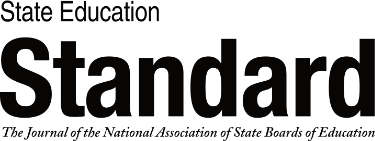State Board Voice: Opening the Door to Opportunities with Ed Tech

Three weeks ago, I visited Boston to see the city and explore the John F. Kennedy Presidential Library. As a son of inner-city Rochester, a city in upstate New York with more in common with cities in the industrial Midwest than on the East Coast, I was astonished at the many cranes stretched across the Boston skyline and the bustling and booming around me. I was also surprised to see several new Americans from all over the world—many attending one of the prestigious colleges in arguably the most established collegiate cluster in the nation or working in the city’s thriving and diverse tech sector or pharmaceuticals.
I also visited the Roxbury, Dorchester, and Southie neighborhoods. I was dismayed for the native Bostonians who were not matriculating in their city’s eminent universities nor had prospects of becoming upwardly mobile via the new opportunities that Boston offers. Given my similar lived experience, I couldn’t help but empathize with them. I know all too well the struggle of trying to succeed when coming from humble beginnings.
As I contemplated this dynamic, I had an a-ha moment. I wasn’t sad to see these community members who had heard and heeded the call of opportunity thrive but rather that many of those who were the subject of my concern and dismay were, like me, never prepared for the future that has now become the present. I knew then that the work of the here and now is to prepare all students today for the inevitable future that will belong to those who are ready for it.
I knew then that the work of the here and now is to prepare all students today for the inevitable future that will belong to those who are ready for it.
As a regent on the New York State Board of Regents, I represent my colleagues on New York’s Technology Policy & Practice Council (TPPC) and have the pleasure of co-chairing NASBE’s EdTech Advisory Group with Kansas State Board of Education chair Melanie Haas.
No resource has more significant implications for the future than technology. It impacts the world of work, the economy, and education. Ed tech, the shorthand for its intersection with education, can be defined as the development of instruments, resources, and platforms to enhance and improve pedagogy, instruction, teaching, and learning to collectively improve the overall performance of our educational systems. As policymakers, our task is to understand the potential of this moment and foster the will and leadership to help effectuate this definition of ed tech.
Yet nationally, state policymakers’ attention is fixed on responding to the Surgeon General’s recent report on the adverse effects of extended screen time and exposure to social media on students’ brains. In New York, there is discussion of a potential cellphone ban in schools.
We leaders must harness the dismay, anxiety, and fear we see and transform it into a healthy expectation and demand on our educational systems to prepare our youth in ways and to a degree we once did not think possible. We do this by assessing, informing, creating, evaluating, and improving.
We leaders must harness the dismay, anxiety, and fear we see and transform it into a healthy expectation.
We must first assess the state of our classrooms, schools, and overall academic systems, asking, “What are we doing? Are we using technology innovatively, optimizing it for students’ benefit, or merely using it to make instruction virtual?”
We must inform the public, actualizing their skepticism into the appropriate guardrails to keep children safe and thereby alleviate much of the doom and gloom that keeps them from channeling energies positively and productively for all.
We must create policies that equip teachers to wield these powerful tools, giving them the freedom and support to reimagine the classroom and instruction and expand how they assess a student’s capabilities. We can advocate for and provide funding to outfit learning environments accordingly.
Most important, we must evaluate our work and the trends, shifts, and advances in our communities and schools and be willing to make adjustments and corrections to ensure we are preparing the next generation of Americans to thrive in the world to come.
With the new tools come incredible promise and potential. What comes of this potential will be dictated by who we are, who we are becoming, and even more, who we are striving to be. With the accumulation of skills that make us capable of harnessing the power of ed tech so it can be leveraged and applied in constructive, productive ways, we must also not forget to advance the human condition, which will be the greatest guarantee against the ill use and exploitation of these tools. Alternatively, we will act and create in ways that, more likely than not, freeze all our problems in place. In the words of my TPPC colleague Ellen Meier, executive director, Center for Technology & School Change at Columbia University, “We will only be digitizing the status quo.”
What comes of this potential will be dictated by who we are, who we are becoming, and even more, who we are striving to be.
Our NASBE EdTech Advisory group seeks to catalyze all the aforementioned courses of action to ensure that policymakers and those charged to our care are prepared to perform in this critical, exciting time. If you are interested in joining NASBE’s advisory group or learning more, don’t hesitate to reach out to me at regent.hale@nysed.gov or to my colleague Melanie Haas at mhaas@ksde.org.
Also In this Issue
State Education Policy and the New Artificial Intelligence
By Glenn M. Kleiman and H. Alix GallagherThe technology is new, but the challenges are familiar.
Opportunities and Challenges: Insights from North Carolina’s AI Guidelines
By Vera CuberoEarly guidance helps all schools seize the technology’s potential and mitigate the risks.
Connecting the National Educational Technology Plan to State Policy: A Roadmap for State Boards
By Julia FallonState leaders can use the plan to gauge whether their policies are expanding technology access, teachers’ capacity, and the learning experience.
Navigating Systemic Access to Computer Science Learning
By Janice MakReal advances to broaden participation in K-12 computing will come when state boards take a 360-degree view.
Ensuring Student Data Privacy through Better Governance
By Paige KowalskiState boards should champion laws to stand up robust cross-agency boards and advocate for best practice.
Advancing Policy to Foster K-12 Media Literacy
By Samia Alkam and Daniela DiGiacomoSome state leaders are moving to provide students with what they need to better navigate the digital world. More should.
Shielding Student Data: The Critical Role of State Boards in K-12 Cybersecurity
By Reg LeichtyA coordinated push is needed to ward off increased threats and mounting costs.









 i
i
 i
i
 i
i